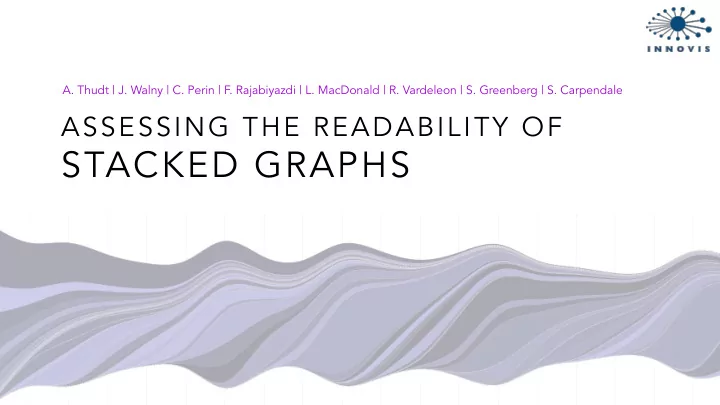

A. Thudt | J. Walny | C. Perin | F. Rajabiyazdi | L. MacDonald | R. Vardeleon | S. Greenberg | S. Carpendale ASSESSING THE READABILITY OF STACKED GRAPHS
STACKED GRAPHS
STACKED GRAPHS
EVOLUTION OF STACKED GRAPHS Stacked Area Chart Themeriver Streamgraph
READABILITY W. S. Cleveland and R. McGill. Graphical Perception: Theory, Experimentation, and Application to the Development of Graphical Methods. Journal of the American Statistical Association , 79(387):531–554,1984.
READABILITY W. S. Cleveland and R. McGill. Graphical Perception: Theory, Experimentation, and Application to the Development of Graphical Methods. Journal of the American Statistical Association , 79(387):531–554,1984.
INFORMATION LEVELS Elementary J. Bertin. Graphics and Graphic Information Processing . Walter de Gruyter & Co, 1981.
INFORMATION LEVELS Elementary Intermediate J. Bertin. Graphics and Graphic Information Processing . Walter de Gruyter & Co, 1981.
INFORMATION LEVELS Elementary Intermediate J. Bertin. Graphics and Graphic Information Processing . Walter de Gruyter & Co, 1981.
INFORMATION LEVELS Elementary Intermediate Global J. Bertin. Graphics and Graphic Information Processing . Walter de Gruyter & Co, 1981.
INFORMATION LEVELS Elementary Intermediate Global J. Bertin. Graphics and Graphic Information Processing . Walter de Gruyter & Co, 1981.
CONDITIONS
STACKED AREA CHART (STACK)
THEMERIVER (THEME) S. Havre, B. Hetzler, and L. Nowell. ThemeRiver: visualizing theme changes over time. IEEE Symposium on Information Visualization, INFOVIS’ 00, 2000.
STREAMGRAPH (STREAM) L. Byron and M. Wattenberg. Stacked graphs–geometry & aesthetics. IEEE TVCG, 14(6):1245–52, 2008.
INTERACTIVE STACKED GRAPH (INT)
DATASETS Random | 30 time-series | 30 time-points 311 Calls in NYC (Calls) | 10 time-series | 35 time-points Box Office Revenue Dataset (Movies) | 300 time-series | 20 time-points
TASKS
I. INDIVIDUAL DISCRIMINATION Which is larger: the value of the blue time-series at A or the value of the yellow time-series at B?
II. STREAM COMPARISON The following area chart represents [time-series data]. In the graph below, which stream represents the same [time-series]?
III. AGGREGATE DISCRIMINATION Is the combined value of all time-series larger at A or at B?
HYPOTHESES H1: Correctness for Aggregated Discrimination (III): STACK > > STREAM THEME INT More Correct Less Correct
HYPOTHESES H2: Correctness for Individual Discrimination (I) and Stream Comparison (II): THEME > > > STACK STREAM INT More Correct Less Correct
HYPOTHESES H3: Completion Time for all tasks: STACK > THEME INT STREA STREAM Faster Slower
16 PARTICIPANTS 9 male, 5 female, 2 did not specify 18–65 years various occupations
STUDY SETUP
STUDY DESIGN within-subjects design balanced 4x4 Latin square training with all tasks for each condition 4 cond × 3 tasks x 3 datasets = 36 trials
DATA
EFFECT SIZES > ¡ strong & large effect strong & small effect > >
EFFECT SIZES weak & large effect ≥ ¡ weak & small effect ≥ ¡
RESULTS
INDIVIDUAL DISCRIMINATION
INDIVIDUAL DISCRIMINATION C o r re c t n e s s STREAM INT Strong & small effect > ¡ THEME STACK More Correct Less Correct
INDIVIDUAL DISCRIMINATION C o m p l e t i o n Ti m e STACK Strong & small effect > ¡ INT INT STREAM Faster Slower
STREAM COMPARISON
STREAM COMPARISON C o r re c t n e s s Strong & small effect > STACK INT Strong & small effect > STREAM ≥ ¡ Weak & large effect THEME More Correct Less Correct
STREAM COMPARISON C o m p l e t i o n Ti m e Strong & small effect > STACK INT Weak & small effect ≥ ¡ THEME Weak & small effect ≥ ¡ STREAM Faster Slower
AGGREGATE DISCRIMINATION
AGGREGATE DISCRIMINATION C o r re c t n e s s THEME Strong & small effect STREAM > More Correct Less Correct
AGGREGATE DISCRIMINATION C o r re c t n e s s THEME Strong & small effect STREAM > INT Strong & small effect > STACK More Correct Less Correct
AGGREGATE DISCRIMINATION C o r re c t n e s s STREAM ≈ 100% Correctness THEME INT STACK
AGGREGATE DISCRIMINATION C o m p l e t i o n Ti m e Strong & small effect THEME > STACK Faster Slower
AGGREGATE DISCRIMINATION C o m p l e t i o n Ti m e > ¡ Strong & large effect STREAM Strong & small effect THEME > STACK > INT Strong & small effect Faster Slower
AGGREGATE DISCRIMINATION C o m p l e t i o n Ti m e > ¡ Strong & large effect STREAM STACK > ¡ INT Strong & large effect Faster Slower
IMPLICATIONS
WHEN TO USE WHICH STACKED GRAPH? STREAM for elementary and global level tasks with static graph
WHEN TO USE WHICH STACKED GRAPH? STREAM for elementary and global level tasks with static graph INT for intermediate and global level tasks
WHEN TO USE WHICH STACKED GRAPH? STREAM for elementary and global level tasks with static graph INT for intermediate and global level tasks STACK did not provide advantage, but perceived as pleasing and easy to read
OTHER IMPLICATIONS Theoretical Models can work to predict perceptual advantages do not show extent of advantages
OTHER IMPLICATIONS Theoretical Models can work to predict perceptual advantages do not show extent of advantages Interaction can be used for mitigating perceptual difficulties avoid increasing memory load
A. Thudt | J. Walny | C. Perin | F. Rajabiyazdi | L. MacDonald | R. Vardeleon | S. Greenberg | S. Carpendale THANK YOU! Project Page: http://j.mp/stackedgraphs
Recommend
More recommend